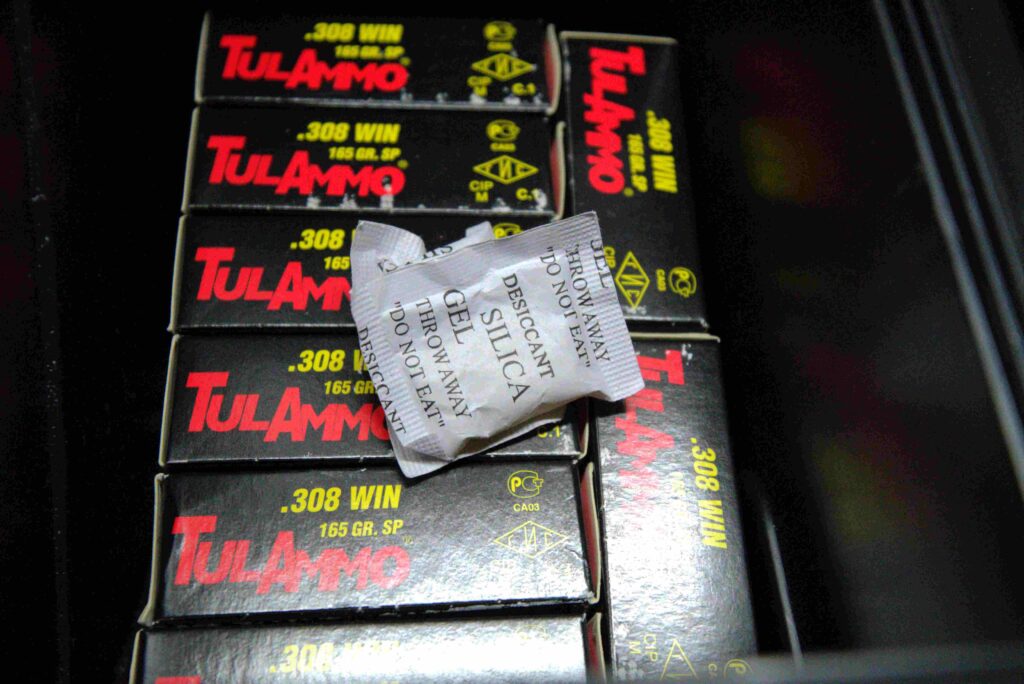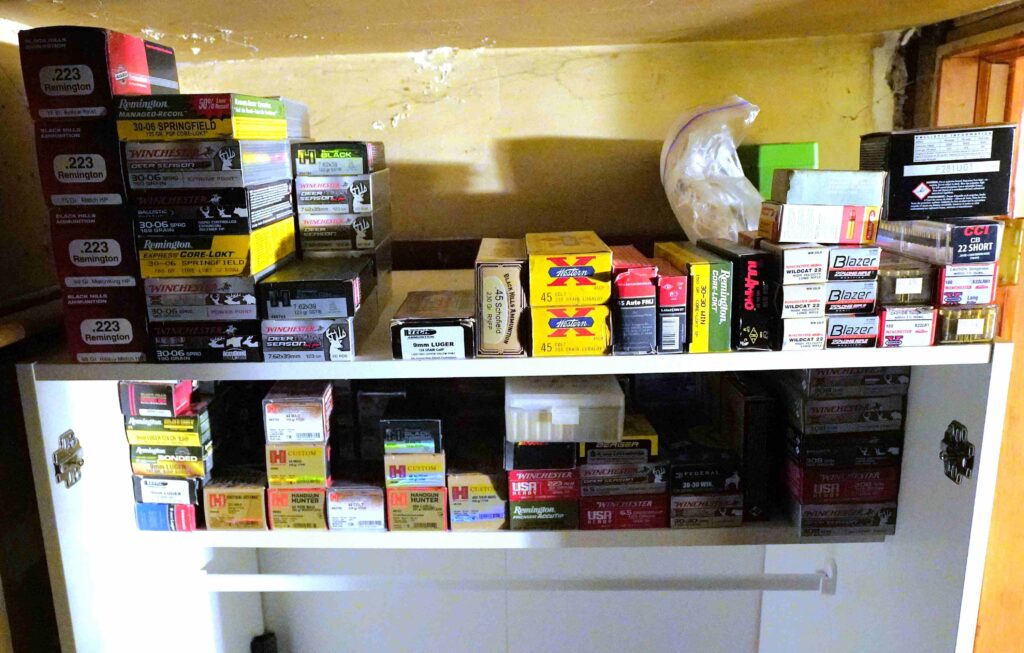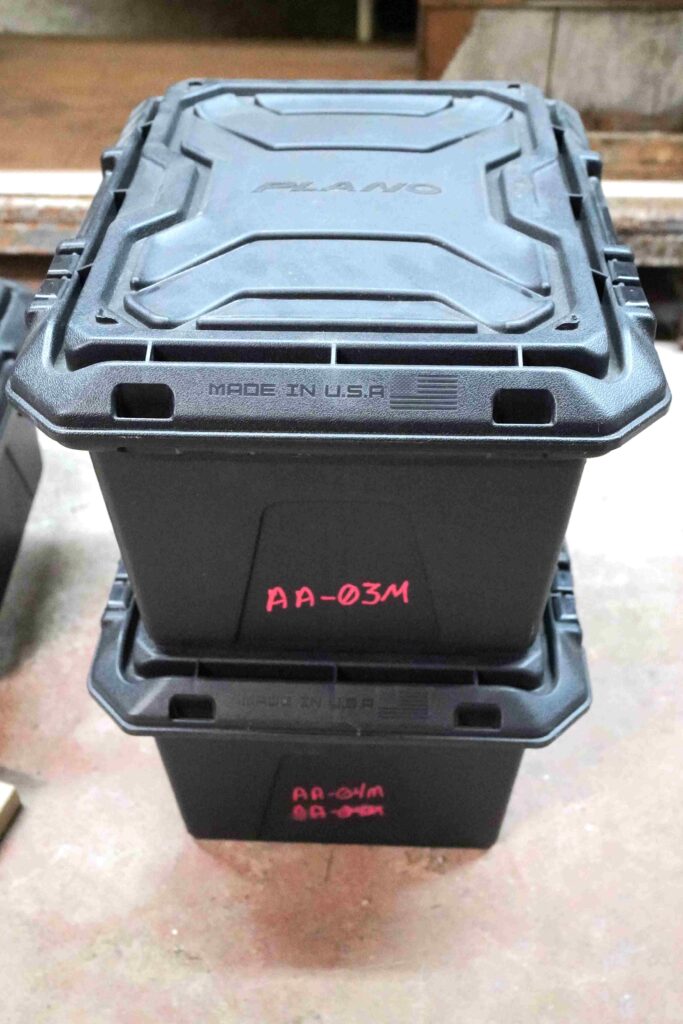
Storing reloaded ammunition has its own potential issues compared to factory loaded rounds. Military spec loaded ammo tends to have additional sealants and specific crimps that are meant to keep moisture out while many precision rounds reduce the crimp or just use neck tension to hold the projectile in place. These alternative load specs will leave space or reduce the effectiveness of protective processes found in factory munitions.
Unfortunately, many individuals have seen their grandfathers and fathers reload and put the cases back into an original box. While this isn’t bad, there are more modern solutions that solve some of the most common environmental concerns. Plastics, while banned in too many places for drinking with, are great for keeping water and damage out.
Ammo cans are popular everywhere. Both newly manufactured and surplus ammo cans can be found relatively easily.
-Protected from the environment
The largest issue to deal with is moisture. It creeps its way in. Keeping ammunition in damp basements or around any type of water source will inevitably cause rot. What this really impairs is the ignition of the gunpowder contained inside the case. Depending on how much moisture has integrated into the case, the primer may even fail to ignite. This may lead to squib loads, delayed hang fires, or inert rounds. All of which can pose potential dangers.

Coming in nearly every new package, these little packets can be saved and used exclusively for keeping your enclosed ammunition dry.
Heat also causes significant issues. Storage within attacks or facilities with high temperature swings. This also impacts the stability of both powder and primers. Along with temperature changes comes expansion of the case or projectile. This can completely change the neck tension that was so skillfully applied. The only solution is keeping these items in areas with stable temperatures.
While preventing this issue may be the same as other listed, the main focus is to protect the ammunition by placing it in sealable containers. The containers, especially those with O-ring gaskets, can be combined with desiccant gel. Desiccant can be collected from packaging or assembled from fresh cat litter. This naturally occurring mineral absorbs moisture from the atmosphere and holds onto it. Once no more moisture can be held, it is possible to bake them dry and reuse. Certain desiccant cat litter types will change color in the presence of humidity and water. Keeping this in any case storing loaded ammunition will quickly remove ambient humidity in enclosed containers.
Vacuum sealable bags provide some extra protection for long-term storage. This will remove as much air as possible. Moisture cannot get into the packaging. Likewise, an entire box or plastic storage container can be vacuum sealed. Vacuum sealed boxes have the ability to be stored in unconventional areas. It’s not uncommon to have someone keep them in underground storage containers, freezers, or basements that have consistent temperatures all year round.

Some cat litters are made with moisture absorbing minerals.
-Protected from damage
A second issue can be impact related damages. While cardboard boxes do offer some protection, they are inadequate for precision loads. Stacking boxes or even putting them upside down may push the projectile into the case. Even a slight variation removes any consistency and pressure will rise the more a projectile is inserted into the shell. For loads that nearly fill up the case, compressing the gun powder leads to dangerous pressure spikes capable of serious bodily harm.

Stacked Factory Boxes isn’t a Great way to store Reloads
The only real solution is proper storage. There are many hard sided options. Plastic reloading boxes, steel ammo cans, plastic cases, etc. Having moisture protection is an added benefit. While some will separate rounds into individual compartments, larger cases will store factory boxes or loose ammunition for overall storage. There is a benefit to large ammo cans as they will hold smaller boxes or can be stacked for vertical holding solutions.
Another issue arises with new storage containers. Users have options of projectile up or projectile down storage even in hard cases. Depending on the load and crimp, either one will work. But when utilizing storage for precision loads, boxes that store the ammunition upright are the most effective at preserving the overall length.

Storing precision loads nose down can affect the overall length of a case and have an impact on accuracy.
This may seem like a great alternative, but prices of these cases can climb, especially when reloading thousands of rounds at a time. Sometimes, the best option is just to pile the heavily crimped plinking ammunition on a moisture and damage resistant ammo can. Don’t hesitate to keep ammunition in an easy to access and moisture resistant location, even if it’s not in a fancy case.
-Protection from animals
Animals can cause both moisture and impact damage. While most damage can be prevented with the methods mentioned above, animals have a way of far exceeding our preparations. There are a few things to consider when storing any ammunition for long periods of time.
Cats and dogs do urinate on items and quickly deteriorate plastics and rubberized components. This includes vacuum sealing plastics. Likewise, rodents and other small animals can chew or tear into packing looking for food only to find your perfect ammunition. Storage in basements or even surrounded by food in a pantry can increase the potential of this happening.
-Protection via documentation
While it may not seem like a likely way to protect your rounds, it can be an essential component. Documenting what ammunition, you’ve loaded keeps it from being fired in a firearm that cannot handle the pressures. Date of load, what powder, type of crimp or neck tension, overall length, how many reloads, and the date of storage allows you to cycle through the rounds to use the older ammunition first.

The author finds it is easier to label everything several times when dealing with a caliber than works well in one firearm and can hurt another.
While time does have an impact on the overall quality and stability of a load, it’s minimal compared to the external influence. When everything else is perfect, time is barely a factor. Regardless, it’s still a good thing to prepare for when outside forces can potentially hurt core fundamental preparations.
-Solutions
Many companies offer products that solve one or more of these issues. My personal preference has been MTM or Plano. Their products solve most of my concerns with reloaded ammunition. While surplus ammo cans are helpful, they’re not always dependable when heavily used or rusted through.
Plano offers many storage solutions
Compounding layers of protection are easy to do with these manufacturer’s systems. MTM, for example, makes smaller ammunition storage cases that hold each piece of loaded cartridges in its own compartment. This, in turn, can be set within a plastic ammo can. MTM also has specifically designed larger storage containers which will hold smaller ammo cans.
MTM Cases Make Excellent Storage Solutions
No matter what option you choose, there are standard dangers. Moisture, impact, animals. Plan for each one and your ammunition will last as long as the surplus dealers say it does.
For a full selection of Ammunition and Reloading storage solutions visit www.midsouthshooterssupply.com











